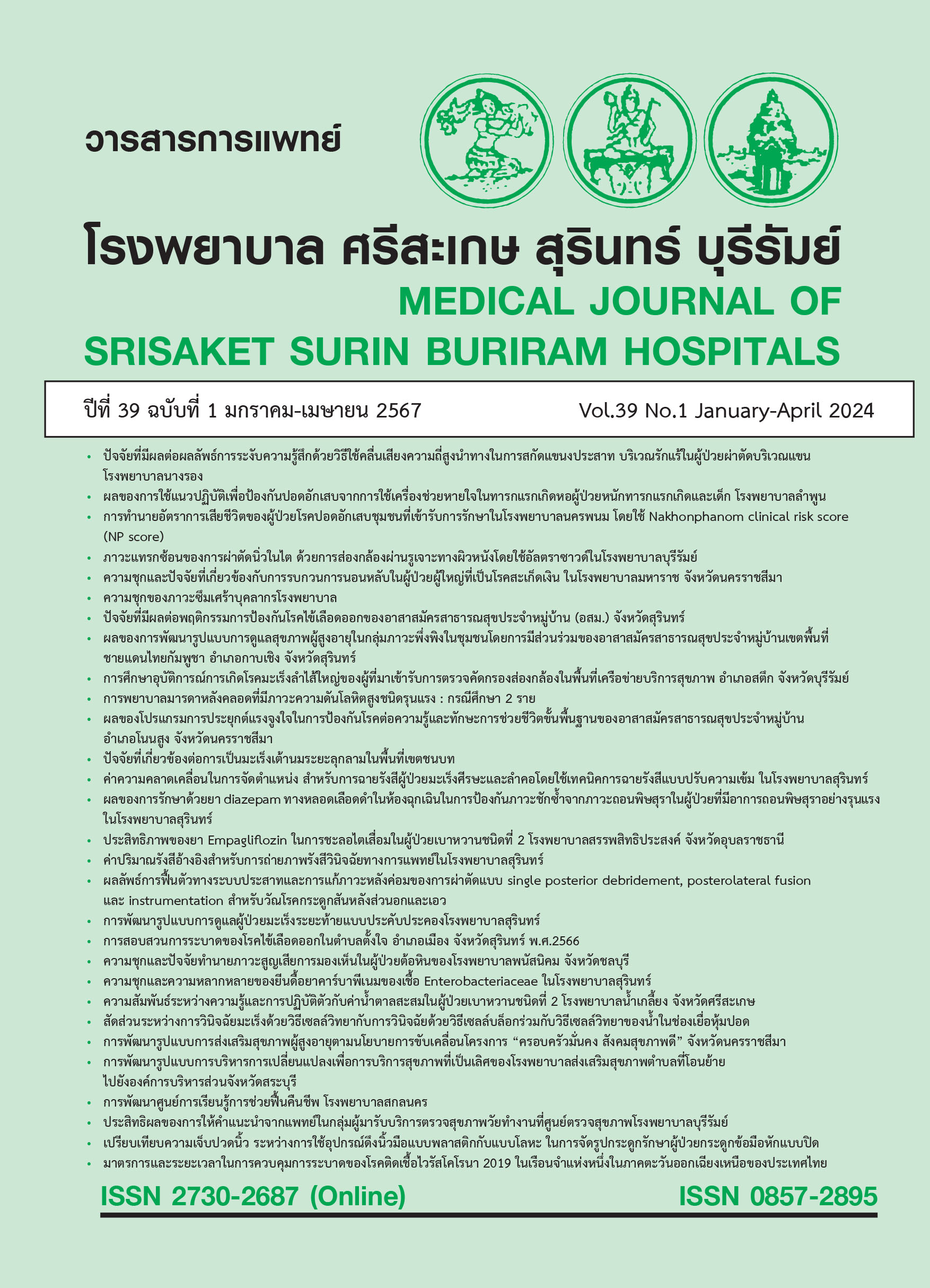ผลลัพธ์การฟื้นตัวทางระบบประสาทและการแก้ภาวะหลังค่อมของการผ่าตัดแบบ single posterior debridement, posterolateral fusion และ instrumentation สำหรับวัณโรคกระดูกสันหลังส่วนอกและเอว
Main Article Content
บทคัดย่อ
หลักการและเหตุผล: อุบัติการณ์ของวัณโรคกำลังเพิ่มขึ้นในประเทศกำลังพัฒนา วัณโรคกระดูกสันหลัง เป็นวัณโรคกระดูกที่พบบ่อยที่สุด ซึ่งคิดเป็นประมาณ ร้อยละ 50 การรักษาหลักคือการให้ยาต้านวัณโรค ในส่วนของวิธีการผ่าตัดยังเป็นที่ถกเถียงกันในเรื่องการผ่าตัดแบบเข้าหน้า เข้าหลัง หรือทั้งหน้าและหลัง ซึ่งการผ่าตัดทางด้านหลังอย่างเดียว มีผลการฟื้นตัวทางระบบประสาทที่ดี แก้ภาวะหลังค่อมได้ดีและภาวะแทรกซ้อนน้อย
วิธีการศึกษา: ศึกษาย้อนหลังเชิงพรรณนา (Descriptive study) ผู้ป่วย 24 ราย ที่ได้รับการวินิจฉัยว่าเป็น วัณโรคกระดูกสันหลังส่วนอกและเอว เพื่อศึกษาผลลัพธ์การฟื้นตัวทางระบบประสาท (ASIA score) และการแก้ภาวะหลังค่อมโดยการวัดมุม (Cobb angle) จากเอกซเรย์ 3 ช่วงเวลา ก่อนผ่าตัด หลังผ่าตัด และติดตามการรักษา 1 ปี ที่เข้ารับการรักษาแบบ single posterior debridement, posterolateral fusion and instrumentation ในโรงพยาบาลศรีสะเกษ ระหว่างเดือน มกราคม พ.ศ. 2560 ถึง ธันวาคม พ.ศ. 2565
ผลการศึกษา: ผู้ป่วยอายุเฉลี่ย 57.3±13.8 ปี, ใช้เวลาการผ่าตัด116.7±43.3 นาที การเสียเลือดระหว่างผ่าตัด 460.4±314.2 มิลลิลิตร ระยะเวลาการนอนโรงพยาบาล 15.3±8.1 วัน วัดมุมหลังค่อมก่อนผ่าตัด หลังผ่าตัด ติดตามการรักษา 1 ปี พบค่าเฉลี่ย 16.8±7.5, 9.5±6.9, 11.8±7.5 องศา ตามลำดับ สามารถแก้ภาวะหลังค่อมหลังผ่าตัดได้ร้อยละ 43 เมื่อเทียบก่อนผ่าตัดและหลังผ่าตัด การแก้มุมหลังค่อมได้อย่างมีนัยสำคัญทางสถิติ (p <0.05) ผลลัพธ์ทางระบบประสาท ASIA score ก่อนผ่าตัด และติดตามการรักษาไปที่ 1 ปี พบระบบประสาทฟื้นตัวดีแบบมีนัยสำคัญทางสถิติ (p <0.05)
สรุป: การผ่าตัด posterior debridement, posterolateral fusion และ instrumentation ในผู้ป่วยวัณโรคกระดูกสันหลังระดับอกและเอว เป็นการผ่าตัดที่ปลอดภัยได้ผลการฟื้นตัวทางระบบประสาทดี และแก้ภาวะหลังค่อม (Kyphosis Cobb angle) ได้ดี
Article Details

อนุญาตภายใต้เงื่อนไข Creative Commons Attribution-NonCommercial-NoDerivatives 4.0 International License.
เอกสารอ้างอิง
Garg RK, Somvanshi DS. Spinal tuberculosis: a review. J Spinal Cord Med 2011;34(5):440-54. doi: 10.1179/2045772311Y.0000000023.
Leowattana W, Leowattana P, Leowattana T. Tuberculosis of the spine. World J Orthop 2023;14(5):275-93. doi: 10.5312/wjo.v14.i5.275.
Glaziou P, Floyd K, Raviglione MC. Global Epidemiology of Tuberculosis. Semin Respir Crit Care Med 2018;39(3):271-85. doi: 10.1055/s-0038-1651492.
Benli IT, Acaroğlu E, Akalin S, Kiş M, Duman E, Un A. Anterior radical debridement and anterior instrumentation in tuberculosis spondylitis. Eur Spine J 2003;12(2):224-34. doi: 10.1007/s00586-002-0403-0.
Zhong N, Kong J, Sun Z, Qian M, Liu T, Xiao J. One-stage Posterior Approach in the Treatment of Consecutive Multi-segment Thoracic Tuberculosis with Kyphosis. Turk Neurosurg 2018;28(3):439-46. doi: 10.5137/1019-5149.JTN.19263-16.2.
Wang LJ, Zhang HQ, Tang MX, Gao QL, Zhou ZH, Yin XH. Comparison of Three Surgical Approaches for Thoracic Spinal Tuberculosis in Adult: Minimum 5-Year Follow Up. Spine (Phila Pa 1976) 2017;42(11):808-17. doi: 10.1097/BRS.0000000000001955.
Tang Y, Wu WJ, Yang S, Wang DG, Zhang Q, Liu X, et al. Surgical treatment of thoracolumbar spinal tuberculosis-a multicentre, retrospective, case-control study. J Orthop Surg Res 2019;14(1):233. doi: 10.1186/s13018-019-1252-4.
Yi Z, Song Q, Zhou J, Zhou Y. The efficacy of single posterior debridement, bone grafting and instrumentation for the treatment of thoracic spinal tuberculosis. Sci Rep 2021;11(1):3591. doi: 10.1038/s41598-021-83178-0.
Utomo P, Kaldani F, Yanto R, Prijosedjati RA, Yamani AR. Kyphotic angle correction and neurological status evaluation after operation in spinal tuberculosis patients: Single center retrospective study. Indian J Tuberc 2021;68(4):464-9. doi: 10.1016/j.ijtb.2021.02.006
Bian Z, Gui Y, Feng F, Shen H, Lao L. Comparison of anterior, posterior, and anterior combined with posterior surgical treatment of thoracic and lumbar spinal tuberculosis: a systematic review. J Int Med Res 2020;48(2):300060519830827. doi: 10.1177/0300060519830827.


